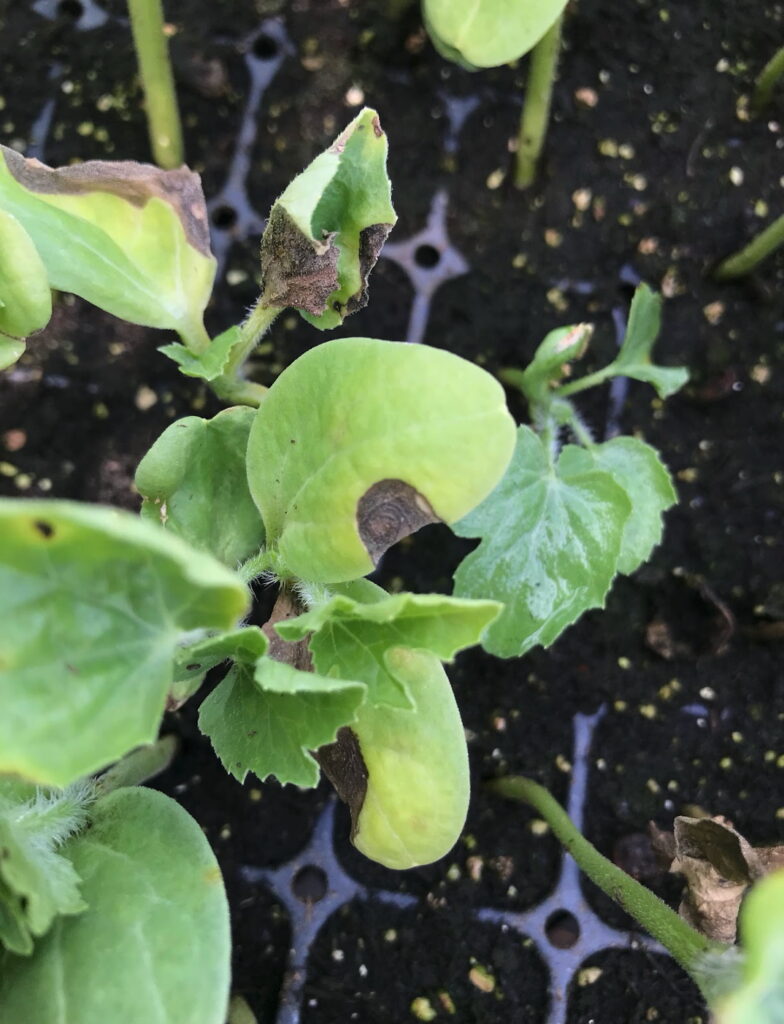Gummy Stem Blight Detected in Watermelon Transplants in North Carolina
go.ncsu.edu/readext?1070955
en Español / em Português
El inglés es el idioma de control de esta página. En la medida en que haya algún conflicto entre la traducción al inglés y la traducción, el inglés prevalece.
Al hacer clic en el enlace de traducción se activa un servicio de traducción gratuito para convertir la página al español. Al igual que con cualquier traducción por Internet, la conversión no es sensible al contexto y puede que no traduzca el texto en su significado original. NC State Extension no garantiza la exactitud del texto traducido. Por favor, tenga en cuenta que algunas aplicaciones y/o servicios pueden no funcionar como se espera cuando se traducen.
Português
Inglês é o idioma de controle desta página. Na medida que haja algum conflito entre o texto original em Inglês e a tradução, o Inglês prevalece.
Ao clicar no link de tradução, um serviço gratuito de tradução será ativado para converter a página para o Português. Como em qualquer tradução pela internet, a conversão não é sensivel ao contexto e pode não ocorrer a tradução para o significado orginal. O serviço de Extensão da Carolina do Norte (NC State Extension) não garante a exatidão do texto traduzido. Por favor, observe que algumas funções ou serviços podem não funcionar como esperado após a tradução.
English
English is the controlling language of this page. To the extent there is any conflict between the English text and the translation, English controls.
Clicking on the translation link activates a free translation service to convert the page to Spanish. As with any Internet translation, the conversion is not context-sensitive and may not translate the text to its original meaning. NC State Extension does not guarantee the accuracy of the translated text. Please note that some applications and/or services may not function as expected when translated.
Collapse ▲In the past couple of weeks we have seen a few cases of watermelon seedlings infected with gummy stem blight. This early detection is concerning, as transplant infections can serve as the initial source of inoculum for field epidemics later in the season. Growers should scout seedlings for gummy stem blight symptoms to prevent introducing the pathogen to fields.
Gummy stem blight (GSB), caused by the fungus Stagonosporopsis cucurbitacearum, affects the leaves, stems, and fruits of all cucurbits. Watermelons are particularly susceptible to this disease. Symptoms in transplants may include water-soaked or dark brown lesions on stems, which can become sunken and necrotic as the disease progresses. A distinguishing feature of gummy stem blight is the presence of sticky, amber-colored sap exuding from infected stem tissues. Leaf lesions may also be present, often circular with tan centers and dark margins. Concentric rings may develop in the leaf spots, giving them a target-like appearance (Fig. 1 and 2). These symptoms can develop rapidly under warm, humid conditions typical of transplant greenhouses and hardening areas (Fig. 3).

Fig. 1: gummy stem blight leaf spots on watermelon leaves and cotyledons (Photo: Erin Eure, NC State Extension)

Fig. 2: gummy stem blight leaf spots on watermelon leaves and cotyledons (Photo: Erin Eure, NC State Extension)

Fig. 3: gummy stem blight infection in a tray of watermelon seedlings (Photo: Erin Eure, NC State Extension)
When transplants are already infected prior to planting, they can introduce the pathogen into the field environment, especially if they are symptomatic but not discarded. Spores produced on infected transplants can be spread by splashing water, equipment, or workers during transplanting and irrigation. This can lead to early and severe field outbreaks, even in areas where rotation and sanitation practices are otherwise well managed.
Growers and transplant producers should inspect watermelon transplants carefully before field setting. If overhead irrigation is used during transplant production, ensure watering is completed early in the day to minimize leaf wetness duration, as this encourages disease growth. Remove and destroy symptomatic plants as much as is practical. Do not attempt to salvage symptomatic plants, as they pose a high risk of pathogen dissemination.
For transplant producers, greenhouse sanitation is essential. Disinfect trays between uses, avoid reuse of potting mix, and maintain adequate airflow to reduce leaf wetness duration. Fungicide programs may be necessary in transplant facilities where infection is suspected or confirmed.
If transplants are already in the field, early detection through scouting and timely fungicide applications will be critical to prevent secondary spread. In dry weather, a less aggressive spray program can be used.
Fungicides listed in our factsheet have shown efficacy against gummy stem blight and are recommended as part of a rotation strategy to minimize resistance development. Samples can be submitted to the NC State Plant Disease and Insect Clinic for confirmation of suspected gummy stem blight infections in transplants.
For further assistance with diagnosis, management options, or fungicide scheduling, please contact your local Extension agent.


